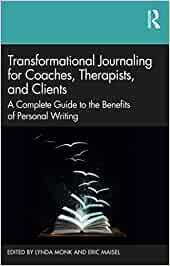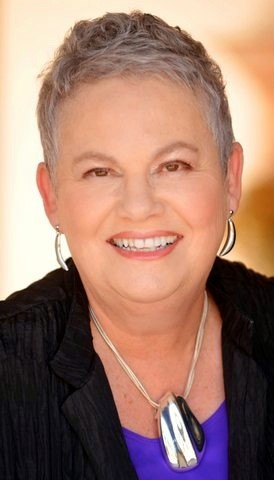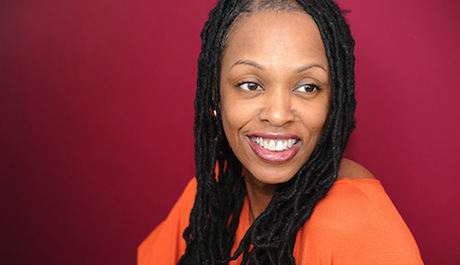 There are many benefits to journaling as the editors and writers of this new, comprehensive collection, Transformational Journaling for Coaches, Therapists, and Clients (Routledge, 2021) illustrate. Among them are gaining perspective, increasing clarity with life decisions, tapping into inner ways of knowing, noticing and clearing limiting beliefs and patterns, and writing the story one wants for their life. As a journal keeper since I learned to write, I can agree with and affirm all of those benefits of personal writing. “Our life narratives . . . hold the thread of our values and desires, while also weaving us into connection with others and the world we live in,” say the co-editors Lynda Monk and Eric Maisel.
There are many benefits to journaling as the editors and writers of this new, comprehensive collection, Transformational Journaling for Coaches, Therapists, and Clients (Routledge, 2021) illustrate. Among them are gaining perspective, increasing clarity with life decisions, tapping into inner ways of knowing, noticing and clearing limiting beliefs and patterns, and writing the story one wants for their life. As a journal keeper since I learned to write, I can agree with and affirm all of those benefits of personal writing. “Our life narratives . . . hold the thread of our values and desires, while also weaving us into connection with others and the world we live in,” say the co-editors Lynda Monk and Eric Maisel.
Among the coaches and therapists who have contributed to Transformational Journaling are some who describe their early days of keeping a journal. Now they’ve become counsellors advising others to do the same. Nicolle Nattrass for instance who has contributed “Creative Journaling for Self-Care,” remembers a diary with a key where she found “journaling was a soft place for me to land.” Nicolle is a Certified Addiction Counselor, playwright, professional actress and workshop facilitator who lives on Vancouver Island, B.C.
Lynda Monk who is co-editor of the book and director of the International Association for Journal Writing (IAJW) also remembers a personal diary with lock and key, realizing during adolescence, “Journaling emerged as something that I did to solve problems, express my feelings, and capture my special memories of daily life.”
 Following her career as s a social worker, Lynda began a training and coaching business specializing in burnout prevention for helpers, healers, and leaders. Her contribution to the collection, “Journaling for Coach and Therapist Self-Care,” has five tips for helping professionals in which Lynda says: “Be sure that if you are recommending journaling to your clients, that you are also engaging with this transformational healing tool in your own life.” She says: “Write about how you are feeling and your own needs and responses, versus the details of your client’s situations.”
Following her career as s a social worker, Lynda began a training and coaching business specializing in burnout prevention for helpers, healers, and leaders. Her contribution to the collection, “Journaling for Coach and Therapist Self-Care,” has five tips for helping professionals in which Lynda says: “Be sure that if you are recommending journaling to your clients, that you are also engaging with this transformational healing tool in your own life.” She says: “Write about how you are feeling and your own needs and responses, versus the details of your client’s situations.”
(Photo of Lynda Monk)
A. M. (Anne) Carley, a creative coach, has been journaling since childhood as well. She remembers writing in a “green spiral notebook” and says: “Over the decades, my journal has become a portal to my wisest, best self.” (from “How Journaling Benefits Your Coaching and Your Clients.”)
There are well-known contributors to the book such as its co-editor Eric Maisel, PhD who has written over fifty books. His essay, “The Focused Journal Method,” is a method of self-inquiry. Others whose names have been familiar to me for years include Kathleen Adams, founder/director of the Center for Journal Therapy; Lucia Capacchione author of The Power of Your Other Hand; and poet and writer Sheila Bender, author of several instruction books on writing. Sheila’s contribution is “Refreshing Experience with the Most Powerful of Writing Craft Tools.”
John Evans is another whose work I have read as he co-authored a book with James Pennebaker called Expressive Writing: Words That Heal. John often teaches at Duke Integrative Medicine and Duke’s Health Humanities Lab and has a private practice at Psychology Associates in Chapel Hill, NC. His essay for this collection is “The Dao of Expressive Writing to Heal” co-authored with Shu Cao Mo, a social entrepreneur advocating for individual and collective transformation through arts and education.
Whether well known or less known to readers, all contributors have something valuable to offer, from their own experience and dedicated research. Following each chapter is a list of tips for counsellors and coaches for working with their clients. There are also tips for clients and journal keepers followed by journaling prompts.
 As Susan Borkin, PhD points out in “A Therapist’s Guide to Using Journaling with Clients,” “[Therapeutic journaling] is an evolving, creative, organic process with few actual rules.” Susan is a psychotherapist, speaker and author of three books on the transformative power of journaling. (Photo of Susan Borkin)
As Susan Borkin, PhD points out in “A Therapist’s Guide to Using Journaling with Clients,” “[Therapeutic journaling] is an evolving, creative, organic process with few actual rules.” Susan is a psychotherapist, speaker and author of three books on the transformative power of journaling. (Photo of Susan Borkin)
Hannah Braime has some good ideas in her essay, “Journaling for Busy Coaches and Clients”. Hannah is a creative coach and author of five books on journaling and self-care. One of her ideas is creating lists such as “10 new things I want to try this year” or “5 places I want to see during my lifetime.” I’m a big fan of lists such as books I’ve read, books I want to read, books I plan to write!
Gail Heney who works with women in recovery has contributed “Writing Through Recovery.” She acknowledges in her essay that she got sober in 2006.
Sandra Marinella wrote a wonderful book, The Story You Need to Tell, and teaches at Integrative Health at Mayo Clinic in Phoenix. Her essay is “Journaling Your Stories for Growth and Healing” in which she outlines “five stages of writing to heal and transform your story and your life.”
 In a section on “Spiritual and Nature Journaling,” Jackee Holder has contributed an essay on “Nature Metaphors for Journaling and Therapeutic Writing.” Jackee lives “in the heart of what was once the great North Wood that covered most of South London.” I love her idea of creating a personal deck of questions using paper luggage tags or something similar. Tree metaphors leading to questions could include such words as rooted, branching out, going out on a limb, blossoming, letting go, planting, seed, growing. (Photo of Jackee Holder)
In a section on “Spiritual and Nature Journaling,” Jackee Holder has contributed an essay on “Nature Metaphors for Journaling and Therapeutic Writing.” Jackee lives “in the heart of what was once the great North Wood that covered most of South London.” I love her idea of creating a personal deck of questions using paper luggage tags or something similar. Tree metaphors leading to questions could include such words as rooted, branching out, going out on a limb, blossoming, letting go, planting, seed, growing. (Photo of Jackee Holder)
The section entitled “Journaling with Groups and Leaders” includes an essay by Ahava Shira, PhD who co-wrote Writing Alone Together: Journalling in a Circle of Women for Creativity, Compassion and Connection with Lynda Monk and Wendy Judith Cutler.
I was also glad to see “The Women’s Writing Circle: Creating a Community Space Through Writing and Sharing” by Nancy Johnston and Shehna Javeed. I appreciate what the two women have to say: “Bringing women writers together to write in a safe, inclusive, and supportive space supports their self-expression, confidence as writers, and community building.” Nancy and Shehna live in Toronto where Nancy is an associate professor who teaches writing and courses on disability studies at the University of Toronto Scarborough. Shehna has had a long career in higher education administration and student advising.
In the “Techniques and Applications” section is an essay by Cynthia Holloway Kelvin entitled “Journaling with Poetry: Embracing Change Through Poetic Process.” Cynthia is a clinical psychologist, creative therapist, and performance consultant who, in her essay, offers a three-part process including movement.
Whether you are exploring the use of journaling in your professional or in your personal practice, there is lots of support here. And if you already have a regular journaling practice and thought you knew all there is to know, not so! There are so many rich resources in Transformational Journaling for Coaches, Therapists, and Clients, gathered into one place, with more than 50 journaling experts offering renewal and rejuvenation through journaling. As the co-editors say: “Journaling is an essential tool and practice for living a more conscious and awakened life.”

Have it, use it, love it!!!! I’ve been practicing journal transition writing with women’s groups for 20 years and this compilation still teaches me a lot!
Ince again MaryAnn you have a wonderful review of what sounds like a great book. Thanks for all the inspirational ideas and connections you help us all make with like hearted folks and writers.
Thanks for writing this wonderful review, Mary Ann!